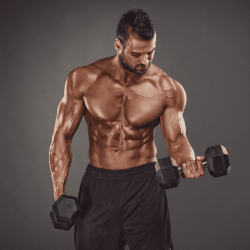How Many Calories Should You Burn in a Workout?

The number of calories you should burn in a workout can vary greatly based on several factors, including your weight, intensity level, and the type of exercise you do. As a rough estimate, a person weighing 150 pounds can expect to burn around 100 calories in 30 minutes of moderate exercises, such as brisk walking, and approximately 200 calories in an hour of more intense activity, such as running. However, these are just estimates, and the actual number may vary based on individual differences. To get a more accurate estimate of the calories burned during your workout, it’s best to use a heart rate monitor or a fitness tracking device.
What exercise burns the most calories?
Several exercises can burn a high number of calories, but the exact amount will depend on factors such as intensity level, duration, and individual differences. However, some of the most calorie-intensive exercises include:
High-intensity interval training (HIIT) – HIIT can burn a significant amount of calories in a short amount of time.
Running or jogging – Running can burn up to 1000 calories per hour for a person weighing 150 pounds.
Swimming – Swimming can burn around 500-700 calories per hour, making it an effective calorie burner.
Rowing – Rowing can burn between 600 and 800 calories per hour, depending on intensity.
Cycling – Cycling can burn between 400 and 700 calories per hour, depending on intensity and terrain.
It’s important to keep in mind that the actual number of calories burned will depend on individual factors such as weight, age, and muscle mass.
Calorie burn for weight management
The number of calories burned during exercise varies based on factors such as your weight, intensity level, and duration of the workout. As a general estimate, a person weighing 150 pounds can expect to burn around 100 calories in 30 minutes of moderate exercises, such as brisk walking, and approximately 200 calories in an hour of more intense activity, such as running. However, these are just rough estimates and the actual number of calories burned can vary based on individual differences. To get a more accurate estimate, consider using a heart rate monitor or a fitness tracking device.
It’s important to remember that weight management is a gradual process and it’s recommended to aim for slow and steady progress, rather than rapid weight loss. Consult with a doctor or a registered dietitian for personalized advice on how to create a healthy and sustainable calorie deficit.
What factors influence the amount of caloric burn?
There are several factors that influence the number of calories burned during physical activity, including:
Body weight – Heavier individuals typically burn more calories than lighter individuals during the same activity, as they have to work harder to move their bodies.
Intensity level – More intense activities tend to burn more calories than less intense activities.
Duration of the workout – The longer the workout, the more calories are burned.
Age – As we age, our metabolism naturally slows down, and we tend to burn fewer calories during physical activity.
Gender – Men typically burn more calories than women during the same activity due to differences in muscle mass and metabolism.
Muscle mass – Individuals with higher muscle mass tend to burn more calories than those with less muscle mass, even when at rest.
Genetics – Some people may have a naturally higher metabolism and may burn more calories than others during the same activity.
It’s important to keep in mind that the actual number of calories burned during physical activity can vary greatly based on individual differences and can be influenced by many factors. To get a more accurate estimate, consider using a heart rate monitor or a fitness tracking device.
Overall, any exercise is good exercise
Yes, overall, any exercise is good exercise. Physical activity is beneficial for overall health, regardless of the type or intensity of the exercise. Regular physical activity can help improve cardiovascular health, strengthen muscles and bones, and boost mental health. It can also help with weight management by burning calories and increasing energy expenditure.
Strength training
Strength training, also known as resistance training, is a type of exercise that uses resistance to build muscle strength, endurance, and mass. This can be achieved through the use of free weights, weight machines, resistance bands, or bodyweight exercises. Strength training is an important aspect of a well-rounded exercise program and can offer numerous benefits, including:
Improving bone density – Strength training can help increase bone density and reduce the risk of osteoporosis.
Building muscle mass – Strength training can help increase muscle mass, leading to an improvement in overall body composition.
Boosting metabolism – Building muscle mass through strength training can lead to an increase in resting metabolism, allowing the body to burn more calories even when at rest.
Improving athletic performance – Strength training can help improve athletic performance by increasing strength, power, and endurance.
Enhancing functional fitness – Strength training can improve functional fitness, making everyday activities easier and reducing the risk of injury.
It’s recommended to incorporate strength training into your exercise routine two to three times per week, with a focus on working for all major muscle groups. It’s important to seek the guidance of a qualified professional, such as a personal trainer or physical therapist, to design a safe and effective strength training program.
High intensity interval training (HIIT)
High-Intensity Interval Training (HIIT) is a type of exercise that alternates short bursts of high-intensity effort with periods of recovery. HIIT workouts are designed to be fast-paced and intense, pushing the body to its limits. The high-intensity intervals can be performed through a variety of exercises, such as running, jumping, cycling, or resistance training.
Some benefits of HIIT include:
Increased calorie burn – HIIT workouts can be an effective way to burn a large number of calories in a short amount of time.
Improved cardiovascular fitness – HIIT workouts can help improve cardiovascular fitness by increasing heart rate and challenging the cardiovascular system.
Increased endurance – HIIT workouts can help improve endurance by training the body to work harder and recover faster.
Increased metabolism – HIIT workouts can lead to an increase in resting metabolism, allowing the body to burn more calories even when at rest.
Time-efficient – HIIT workouts are often shorter in duration compared to traditional, steady-state cardio workouts, making them a convenient option for those with busy schedules.
It’s important to approach HIIT workouts with caution, as they can be physically demanding and may not be suitable for everyone. It’s recommended to seek the guidance of a qualified professional, such as a personal trainer or exercise specialist, to design a safe and effective HIIT program. Additionally, it’s important to listen to your body and adjust the intensity level as needed to prevent injury and maintain proper form.
Cycling
Cycling is a form of aerobic exercise that involves riding a bicycle, either outdoors or on a stationary bike. Cycling can provide a low-impact cardiovascular workout and can be a fun and effective way to improve fitness and burn calories.
Some benefits of cycling include:
Improved cardiovascular health – Cycling is a great cardiovascular workout that can help improve heart health and endurance.
Increased calorie burn – Cycling can be an effective way to burn a large number of calories in a short amount of time.
Low-impact workout – Cycling is a low-impact form of exercise that is easy on the joints, making it a good option for those with joint pain or injuries.
Improved muscle endurance – Cycling can help improve muscle endurance in the legs, hips, and glutes.
Convenient – Cycling can be done almost anywhere, making it a convenient form of exercise that can be easily incorporated into a busy lifestyle.
Whether you’re riding outdoors or using a stationary bike, it’s important to choose a comfortable and well-fitted bicycle and to wear appropriate safety gear, such as a helmet, when riding. It’s also important to start slowly and gradually increase intensity and duration over time to prevent injury and avoid overtraining.
Jump rope
Jump rope is a form of cardio exercise that involves jumping over a rope that is swinging under your feet. Jump rope is a high-impact exercise that can be an effective way to improve cardiovascular fitness and burn calories.
Some benefits of jump rope include:
Increased calorie burn – Jump rope can be an effective way to burn a large number of calories in a short amount of time.
Improved cardiovascular fitness – Jump rope is a great cardiovascular workout that can help improve heart health and endurance.
Improved coordination and balance – Jump rope requires coordination and balance, making it an effective way to improve these skills.
Convenient and portable – Jump ropes are small, portable, and can be used almost anywhere, making them a convenient option for those with busy schedules.
Low-cost – Jump ropes are relatively inexpensive compared to other forms of exercise equipment, making them a cost-effective option for those on a tight budget.
It’s important to start slowly and gradually increase the intensity and duration of your jump rope sessions to prevent injury and avoid overtraining. It’s also important to choose a comfortable and well-fitting pair of sneakers to jump rope in, as well as to make sure that the rope you are using is the appropriate length for your height.
Running
Running is a form of aerobic exercise that involves moving the body at a fast pace, either outdoors or on a treadmill. Running can provide a high-impact cardiovascular workout and can be a fun and effective way to improve fitness and burn calories.
Some benefits of running include:
Increased calorie burn – Running can be an effective way to burn a large number of calories in a short amount of time.
Improved cardiovascular fitness – Running is a great cardiovascular workout that can help improve heart health and endurance.
Improved muscle endurance – Running can help improve muscle endurance in the legs, hips, and glutes.
Mental health benefits – Running can help improve mental health by reducing stress and anxiety and promoting feelings of well-being.
Convenient – Running can be done almost anywhere, making it a convenient form of exercise that can be easily incorporated into a busy lifestyle.
It’s important to start slowly and gradually increase the intensity and duration of your running sessions to prevent injury and avoid overtraining. It’s also important to choose a comfortable and well-fitting pair of sneakers to run in, as well as to make sure that you are wearing appropriate safety gear, such as reflective clothing and a headlamp, when running at night. Additionally, it’s important to stay hydrated and fueled before, during, and after your runs to maintain energy levels and prevent fatigue.
Swimming
Swimming is a form of aerobic exercise that involves moving the body through water. Swimming provides a low-impact cardiovascular workout and can be a fun and effective way to improve fitness and burn calories.
Some benefits of swimming include:
Low-impact workout – Swimming is a low-impact form of exercise that is easy on the joints, making it a good option for those with joint pain or injuries.
Increased calorie burn – Swimming can be an effective way to burn a large number of calories in a short amount of time.
Improved cardiovascular fitness – Swimming is a great cardiovascular workout that can help improve heart health and endurance.
Full-body workout – Swimming involves the use of multiple muscle groups, making it a great full-body workout.
Mental health benefits – Swimming can help reduce stress and promote feelings of relaxation and well-being.
Whether you’re swimming laps in a pool or doing aquatic aerobics, it’s important to choose a comfortable and well-fitting swimsuit and goggles and to stay hydrated and fueled before, during, and after your swims to maintain energy levels and prevent fatigue. Additionally, it’s important to make sure that you are swimming in a safe and supervised environment and to follow any rules and regulations set forth by the pool or beach.
Boxing
Boxing is a form of high-intensity interval training (HIIT) that involves repetitive punches and footwork, typically done with gloves and a focus mitt or heavy bag. Boxing provides a full-body workout and can be an effective way to improve fitness, build strength and coordination, and burn calories.
Some benefits of boxing include:
Increased calorie burn – Boxing is a high-intensity workout that can burn a large number of calories in a short amount of time.
Improved hand-eye coordination – Boxing requires quick reflexes and good hand-eye coordination, making it an effective way to improve these skills.
Full-body workout – Boxing involves the use of multiple muscle groups, making it a great full-body workout.
Improved cardiovascular fitness – Boxing is a great cardiovascular workout that can help improve heart health and endurance.
Stress relief – Boxing is a physically demanding workout that can help reduce stress and anxiety and promote feelings of well-being.
It’s important to choose a comfortable and well-fitting pair of gloves and hand wraps for boxing and to make sure that you are wearing appropriate safety gear, such as headgear and a mouthguard, to prevent injury. Additionally, it’s important to start slowly and gradually increase the intensity and duration of your boxing sessions to prevent injury and avoid overtraining and to stay hydrated and fueled before, during, and after your workouts to maintain energy levels and prevent fatigue.
Rowing
Rowing is a form of low-impact aerobic exercise that involves using a rowing machine or rowing on water with a rowing shell. Rowing provides a full-body workout that can help improve cardiovascular fitness, build strength, and burn calories.
Some benefits of rowing include:
Low-impact workout – Rowing is a low-impact form of exercise that is easy on the joints, making it a good option for those with joint pain or injuries.
Increased calorie burn – Rowing can be an effective way to burn a large number of calories in a short amount of time.
Improved cardiovascular fitness – Rowing is a great cardiovascular workout that can help improve heart health and endurance.
Full-body workout – Rowing involves the use of multiple muscle groups, making it a great full-body workout.
Mental health benefits – Rowing can help reduce stress and promote feelings of relaxation and well-being.
Whether you’re using a rowing machine or rowing on water, it’s important to make sure that you have a proper rowing form and technique to avoid injury and maximize the benefits of your workout. Additionally, it’s important to stay hydrated and fueled before, during, and after your rowing sessions to maintain energy levels and prevent fatigue.
How to burn more calories during a workout?
Here are some ways to burn more calories during a workout:
Increase the intensity – Doing high-intensity workouts such as HIIT or interval training can help you burn more calories in a shorter amount of time.
Add weight resistance – Incorporating weight resistance into your workout routine, such as using dumbbells or kettlebells, can help you burn more calories and build muscle.
Incorporate compound exercises – Compound exercises that work for multiple muscle groups at once, such as squats or deadlifts, can help you burn more calories and increase your metabolism.
Incorporate plyometric exercises – Plyometric exercises, such as jump squats or burpees, can help increase your heart rate and boost calorie burn.
Add in cardio intervals – Adding short bursts of high-intensity cardio to your workout, such as sprinting or jumping rope, can help increase calorie burn and improve cardiovascular fitness.
Try new activities – Experimenting with new activities, such as dance or sports, can help keep your workouts fun and engaging, while also helping you burn more calories.
It’s important to remember that the actual number of calories burned during a workout can vary depending on factors such as intensity, duration, and body composition, so it’s always best to consult with a healthcare provider or a licensed fitness professional to determine the best workout plan for your needs.
Body weight
Body weight can impact the number of calories burned during a workout. Generally speaking, the more you weigh, the more calories you’ll burn during exercise. This is because your body has to work harder to move a heavier body, resulting in a higher energy expenditure and calorie burn.
However, body composition is also an important factor to consider. Muscle tissue burns more calories at rest than fat tissue, so if you have a higher muscle mass, you may burn more calories during a workout even if you weigh less.
It’s also important to note that the type of exercise, intensity level, and duration of the workout will also impact the number of calories burned. A high-intensity workout may burn more calories in a shorter amount of time compared to a low-intensity workout, for example.
If your goal is to burn a specific number of calories during a workout, it’s best to track your progress using a fitness app or a heart rate monitor to get an accurate estimate of the calories burned. This can help you make adjustments to your workout routine and intensity to reach your fitness goals.
Training intensity
Training intensity refers to the level of effort exerted during a workout. The higher the intensity, the more calories you will burn during the workout. High-intensity workouts, such as HIIT, interval training, or heavy weightlifting, typically burn more calories in a shorter amount of time compared to low-intensity workouts, such as yoga or gentle stretching.
However, it’s important to keep in mind that the level of intensity that’s right for you will depend on several factors, including your fitness level, current health status, and individual goals. It’s always best to start with a lower-intensity workout and gradually increase the intensity as you become more fit and comfortable.
To maximize calorie burn and reach your fitness goals, it’s a good idea to vary your workout routine and include a mix of both high- and low-intensity exercises. This can help prevent boredom, reduce the risk of injury, and improve overall fitness.
It’s also important to listen to your body and avoid pushing yourself too hard, as overtraining can lead to fatigue, injury, and decreased performance. If you experience pain or discomfort during a workout, it’s best to stop and rest or seek medical attention if necessary.
Birth Sex
Birth sex can influence the number of calories burned during a workout, as men and women tend to have differences in body composition, muscle mass, and hormone levels that impact metabolism and calorie burn.
For example, men tend to have a higher percentage of muscle mass and a lower percentage of body fat compared to women, which can result in a higher calorie burn during a workout. Hormonal differences, such as higher levels of testosterone in men and higher levels of estrogen in women, can also impact metabolism and calorie burn.
However, it’s important to keep in mind that these differences are not absolute and can vary widely from person to person. The actual number of calories burned during a workout will depend on a variety of factors, including body composition, age, height, weight, intensity of the workout, and overall health.
It’s also important to note that both men and women can benefit from regular exercise and a balanced diet to maintain a healthy weight and improve overall health and fitness. Whether you are a man or a woman, the most effective way to burn calories and reach your fitness goals is to find an exercise routine that you enjoy and that you can stick to on a regular basis.
Age
Age can affect the number of calories burned during a workout, as metabolism and hormone levels change over time. As you get older, your metabolism naturally slows down, making it more challenging to burn the same number of calories as you did when you were younger.
However, regular exercise can help counteract the decline in metabolism and boost calorie burn, regardless of age. In addition, older adults can benefit from resistance training, which can help build and maintain muscle mass, leading to a higher overall metabolism and calorie burn.
It’s important to keep in mind that the actual number of calories burned during a workout will depend on a variety of factors, including body composition, height, weight, the intensity of the workout, and overall health.
It’s also important to consult with a doctor before starting a new exercise program, especially if you have any health conditions or concerns. A doctor can help you determine the right exercise routine for your specific needs and goals, and ensure that you are able to exercise safely and effectively.
Muscle mass
Muscle mass can have a significant impact on the number of calories burned during a workout, as well as at rest. Muscle tissue is more metabolically active than fat tissue, meaning that it burns more calories even when you are not exercising.
For this reason, having a higher percentage of muscle mass can result in a higher overall metabolism and a higher calorie burn, both during a workout and at rest. Resistance training, such as weightlifting, is an effective way to build and maintain muscle mass, which can lead to increased calorie burn and improved overall health and fitness.
It’s important to keep in mind that the actual number of calories burned during a workout will depend on a variety of factors, including body composition, height, weight, the intensity of the workout, and overall health.
It’s also important to consult with a doctor or a personal trainer to develop an effective resistance training program that is right for you. They can help you determine the right weights and number of repetitions for each exercise, as well as ensure that you are using the proper form and technique to avoid injury.
Fitness levels
Fitness level can impact the number of calories burned during a workout, as someone who is fitter will typically be able to exercise at a higher intensity and for longer periods of time than someone who is less fit.
In general, the more intense the workout and the longer its duration, the more calories you will burn. However, it’s also important to remember that calorie burn is not the only factor to consider when evaluating the effectiveness of a workout. Regular exercise can have numerous health benefits, including improved cardiovascular health, increased strength and flexibility, and reduced risk of chronic diseases, regardless of the number of calories burned.
It’s important to start at a level that is appropriate for your current fitness level and gradually increase intensity and duration over time as your fitness improves. This will help prevent injury and ensure that you are able to progress and reach your fitness goals in a safe and sustainable way.
It’s also important to consult with a doctor or a personal trainer to develop an exercise program that is right for you. They can help you determine the best type and frequency of exercise to help you reach your fitness goals, and ensure that you are exercising safely and effectively.
Can running backwards really help burn calories, work your heart and build muscle?
Running backwards can indeed burn calories, work your heart, and potentially build muscle, but it may also carry an increased risk of injury compared to forward running.
Running backwards can be a more challenging form of exercise as it requires your body to work in a different way and engage different muscle groups, which can lead to an increased calorie burn and improved cardiovascular fitness.
However, running backward also requires a higher level of coordination and balance, and there is a greater risk of tripping or falling compared to forward running. It’s important to start slowly and progress gradually when incorporating backward running into your workout routine, and to seek the guidance of a personal trainer or coach if you’re new to this form of exercise.
It’s also important to consult with a doctor before starting any new exercise program, especially if you have any existing medical conditions or concerns. They can help determine if running backward is safe and appropriate for you and help you develop a safe and effective workout plan.
It’s recommended to aim for at least 30 minutes of moderate-intensity physical activity most days of the week. This can be achieved through a variety of activities, such as walking, cycling, swimming, or other forms of cardio. Resistance training, such as weightlifting or bodyweight exercises, can also be included as part of a well-rounded exercise program to build muscle and improve overall fitness.
It’s important to find an exercise that you enjoy and that fits into your lifestyle, as this can help increase the chances of making it a regular part of your routine.
Men’s trending fashion and how to look attractive. Here teaching fashion, so make sure to check it out.
Men’s Fitness tips, what you eat and how to stay fit your body. The best workout and best diet plan, so make sure to check it out.
Men’s lifestyle tips, how to live a better life, and changing your lifestyle tips, so make sure to check them out.
It cannot be denied that men have finally come to their senses when it comes to good grooming and fashion statement.
Men are also equally frustrated with bad hair days in their life, even though not as annoyed as women. Even though men have short haircuts, they also face problems in maintaining their hair.
There are no formulae for success but there are some successful entrepreneur tips that can help make things a little simpler.









